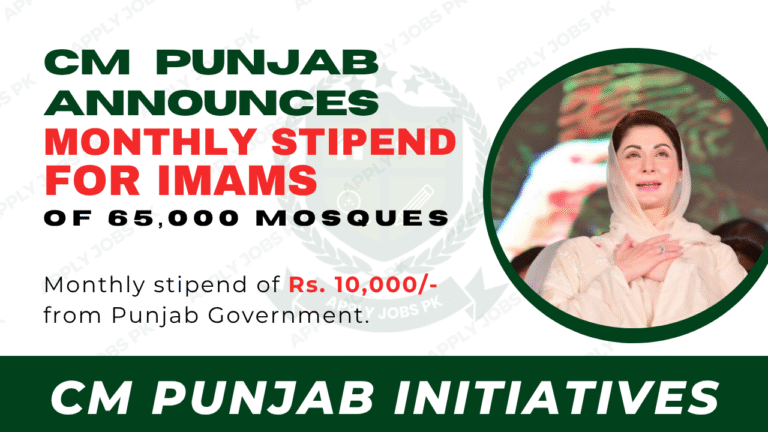CM Punjab Free WiFi Program 2025: Empowering students, freelancers & businesses with over 1400 free internet hotspots across Punjab.

Access to digital services is quickly becoming as essential as electricity and water for everyday life. Recognising this shift, the Government of Punjab under the leadership of Maryam Nawaz has launched the Punjab Free WiFi 2025 initiative — an ambitious effort to bring free, fast and secure internet access to millions of citizens across the province. This is the digital inclusion move many have been waiting for: students in remote towns, freelancers in cafés, market vendors selling online and families staying connected—all empowered by free public WiFi across Punjab.
This article delves into every aspect of the Punjab Free WiFi 2025 initiative: its purpose, rollout, how to connect, benefits, technical setup, security considerations and future plans for statewide implementation.
Why Punjab Free WiFi 2025? Building a Digital Punjab
In her vision for a modern-and-inclusive Punjab, Chief Minister Maryam Nawaz has placed digital infrastructure at the heart of public policy. The idea behind the Punjab Free WiFi 2025 program is simple: internet access should not be a luxury reserved for urban elites, but a basic right for all citizens. By offering free WiFi in public spaces, the government aims to:
- Narrow the digital divide between urban and rural areas
- Support students who need connectivity for online classes or research
- Enable freelancers and small business owners to participate in the digital economy
- Allow public servants and citizens to access e-governance platforms seamlessly
Rather than being merely a headline-initiative, the Punjab Free WiFi 2025 contributes directly to the broader “Digital Punjab” and “Digital Pakistan” agendas, positioning the province to compete in a fast-changing global tech environment.
What the Program Covers: Scope & Scale
Coverage and Infrastructure
The publicly documented rollout of the Punjab Free WiFi 2025 initiative indicates:
- Over 1,400 locations across Punjab now host free WiFi hotspots.
- In Lahore alone, the number of hotspots increased to 442 locations by late 2025.
- Expansion from an initial 11-district coverage to at least 22 districts or more across Punjab.
- Hotspots installed at universities, parks, hospitals, bus stations, railway terminals and other public places.
Speed & Technology
While the official published minimum speeds vary, reports note the adoption of WiFi-6 technology, which offers faster speeds and better performance for high-density use (such as universities or transit hubs).
User Reach & Data Usage
- More than 58 million users have used the service and consumed around 1,191 terabytes of data in selected locations.
- In major urban hubs, daily usage averages around 4.5 terabytes from over 350,000 connected devices.
These figures indicate that the Punjab Free WiFi 2025 rollout is not just symbolic—it’s heavily utilised and meeting real public demand.
How to Connect: Step-by-Step Guide
Connecting to the Punjab Free WiFi 2025 network is designed to be simple and user-friendly:
- Enable WiFi on your smartphone, tablet or laptop.
- In the list of available networks, select the official network name (e.g., “Punjab Free WiFi” or similar signage at hotspot).
- A login/portal page will appear automatically. If it doesn’t, open a browser and navigate to any website—it will redirect you.
- Authenticate via your CNIC number and mobile number or the login method shown on the portal.
- Accept terms & conditions, then press Connect. You are now online via the free public hotspot.
- Use your device for browsing, research, video calls, downloads (subject to fair-usage policy) and digital services.
Tip: If you cannot connect, verify that your SIM number is registered under your CNIC, and ensure you are within a hotspot zone.
Who Benefits from the Program?
Students & Learners
With free connectivity, students from under-privileged households or remote towns can now access online lectures, digital libraries, tutorial videos, research resources and collaborative tools—without relying solely on paid mobile data.
Freelancers & Digital Workers
Punjab has a growing base of freelancers, content creators and gig-economy workers. Reliable and free WiFi at convenient public hubs means fewer data costs and more productive work-spaces. The Punjab Free WiFi 2025 enables them to connect, deliver tasks and access global platforms more easily.
Small Businesses & Entrepreneurs
Local businesses—shops, cafés, market vendors—can use the free WiFi to manage digital payments, market via social media, operate online storefronts and leverage connectivity to grow. This helps build Punjab’s digital economy from the ground up.
General Public & Visitors
Tourists and daily commuters also benefit: free WiFi at parks, bus terminals and railway stations allows accessing maps, making calls, downloading tickets, streaming information, or staying connected with friends and family.
Combined, these use-cases move beyond mere access—they enable participation in the digital economy, which is what the Punjab Free WiFi 2025 initiative is really about.
Integration with Smart City & E-Governance Services
The gap between internet access and meaningful digital services is narrowing thanks to the program’s integration with wider technical infrastructure:
- The WiFi network supports Smart City services such as traffic monitoring, security cameras and sensor networks in public hubs.
- Through public WiFi access, citizens can use e-governance portals, welfare scheme platforms, health-services websites and other online government systems without using mobile data.
- By enabling connectivity at public locations (hospitals, universities, bus stations), the Punjab Free WiFi 2025 initiative complements larger provincial targets of digital governance and public-service delivery.
This layered integration means the free WiFi network is not just a public access tool—it is part of Punjab’s shift toward a digitally-enabled public sector and economy.
Security, Data Management & Fair Usage
Providing free public WiFi at scale requires careful policies for security and fair usage. The Punjab Free WiFi 2025 program addresses these challenges through:
- User authentication: Access requires CNIC and/or mobile registration to ensure accountability.
- Encryption & firewalls: Hotspots are secured through central monitoring and cybersecurity protocols to protect users and networks.
- Fair-usage policy (FUP): While many users enjoy the service, limits may apply (e.g., per-session data caps, time limits) to prevent abuse and maintain speed. Some news reports mention ~1 GB per session in certain sites.
- Maintenance & monitoring: Dedicated support via helpline and control-rooms is in place for outage resolution and hotspot performance.
These safeguards strengthen trust in the system and ensure the Punjab Free WiFi 2025 initiative remains sustainable and equitable.
Reaching Rural & Semi-Urban Areas: Bridging the Digital Divide
While urban centres like Lahore, Rawalpindi and Multan have benefitted early, the true value of the Punjab Free WiFi 2025 lies in extending coverage to semi-urban and rural districts:
- Many reports confirm expansion to 22+ districts, reaching districts such as Kasur, Nankana Sahib, Sheikhupura, Sialkot, Gujrat, Jhelum, Attock and Murree.
- Hotspots are being installed at educational colleges, rural hospitals, bus-stands and tehsil centres—making connectivity closer to home for many Pakistanis.
- Over 1,400 total spots across province signal intent: a truly province-wide digital infrastructure rather than a city-only initiative.
By bringing connectivity to underserved regions, the government ensures that the Punjab Free WiFi 2025 initiative promotes inclusive access to the digital economy—not just for the urban middle class but for all citizens.
How the Roll-out Has Progressed
Early pilot & launch
The initiative started with pilot installations: 50 hotspots in Lahore were launched under CM Maryam Nawaz’s oversight in 2024.
Scaling up
Over time, installations expanded across key public locations and districts. By early 2025, more than 200 locations in Lahore were active.
Large-scale deployment
Later in 2025, Punjab reported over 1,400 hotspot locations and significant user-counts, reinforcing the success of the initiative.
Infrastructure upgrades
In mid-2025 the network was upgraded to WiFi-6, enabling higher throughput and better performance in crowded areas.
These phases show the journey of the Punjab Free WiFi 2025 initiative—from pilot to province-wide rollout.
Challenges & Considerations
While the scope and ambition of the Punjab Free WiFi 2025 program are commendable, a few practical challenges merit attention:
- Connectivity speed in peak times: High traffic hotspots may experience slower speeds if usage overwhelms capacity.
- Device registration and CNIC verification: Some users may face difficulties if their mobile or CNIC is not properly registered.
- Rural infrastructure gaps: Ensuring consistent power and connectivity in remote areas remains a challenge.
- Maintenance & sustainability: Keeping hardware operational, secure and updated across 1,400+ locations requires steady resources and oversight.
- Fair usage enforcement: Without strict FUP policies, some users may hog bandwidth, affecting service quality for others.
Acknowledging and planning for these challenges will help sustain the gains of the Punjab Free WiFi 2025 initiative for years to come.
Access Tips & Best Practices
- Use the nearest visible “Free WiFi” signage at public parks, universities, hospitals or transit hubs.
- Always verify the network name is official (look for “Punjab Free WiFi” or similar) before logging in.
- Use your CNIC/mobile number correctly and keep your SIM active.
- Avoid banking or sensitive transactions on public WiFi unless you have a trusted VPN.
- If connection fails, check your device’s WiFi settings, browser redirect or ask at the location’s information counter.
- Keep your ward’s children using the network safe by supervising usage and avoiding inappropriate sites.
Following these steps ensures you make the most of the Punjab Free WiFi 2025 service safely and effectively.
CM Punjab Free WiFi Expansion and Future Vision
The journey of the Punjab Free WiFi 2025 initiative continues with further ambitions:
- Expand to all tehsil and union-council offices, bus terminals, train stations and remote public locations.
- Integrate hotspot access with digital ID systems, e-learning portals, healthcare apps and digital government services.
- Monitor and improve network analytics: usage trends, devices connected, performance gaps.
- Pilot rural-mesh networks and satellite-backed connectivity for very remote areas.
- Collaborate with private sector and international partners for innovation and accelerated deployment.
Ultimately, the Punjab Free WiFi 2025 initiative aims to make the province a fully-connected digital region where every citizen has access to the internet and the opportunities it unlocks.
Real-Life Impact
Imagine Ayesha, a young student from a public college in Rawalpindi. She used to rely on expensive mobile data or travel to cafes. Now, with accessible free WiFi near campus, she downloads research papers, attends online lectures and collaborates with classmates via group projects—all without worrying about data cost. That’s the kind of everyday transformation the Punjab Free WiFi 2025 program brings.
For freelancers like Ali, who works on graphic-design gigs from his hometown in Gujrat, being able to log in at a public hotspot with stable WiFi means deadlines are met, clients kept happy and earning potential increased.
Smaller businesses near these hotspots also see more footfall: customers stay longer, use digital payments and ask about online channels. The ecosystem grows.
Such real-life gains reflect the broader vision: connectivity isn’t just about browsing, it’s about accessing opportunity.
Final Thoughts
The Punjab Free WiFi 2025 initiative under CM Maryam Nawaz is an ambitious, well-executed step toward digital inclusion. With over 1,400 hotspot locations, tens of millions of users served and rapid infrastructure upgrades, this program is laying the digital foundation for a connected, inclusive Punjab.
If you are a student, freelancer, business-owner or simply a citizen seeking better access to digital tools, this initiative is your entry-point to a richer digital life. Make use of it, stay safe, share the benefit with others—and help build a Punjab where every person is connected, empowered and ready for the future.
Stay connected. Stay empowered. The digital journey of Punjab is just getting started.







